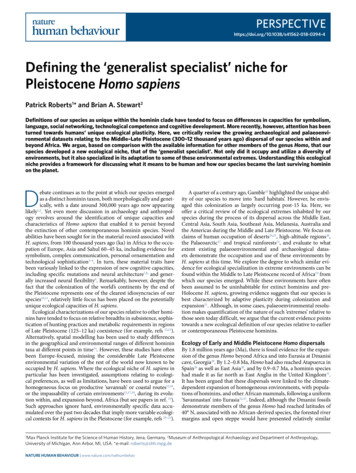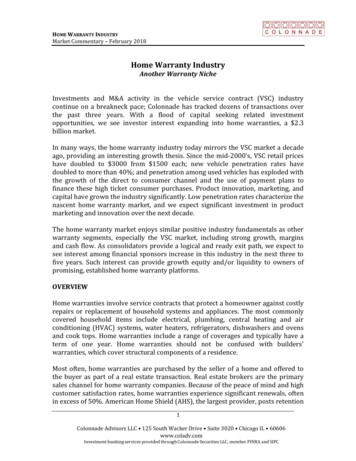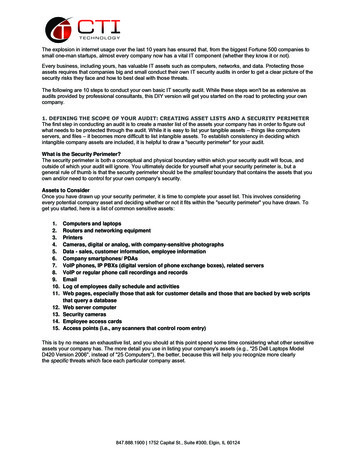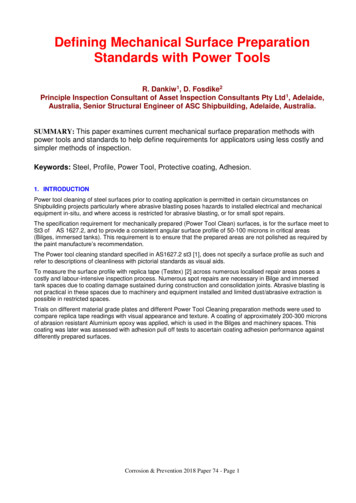
Transcription
-4Defining the ‘generalist specialist’ niche forPleistocene Homo sapiensPatrick Roberts1* and Brian A. Stewart2Definitions of our species as unique within the hominin clade have tended to focus on differences in capacities for symbolism,language, social networking, technological competence and cognitive development. More recently, however, attention has beenturned towards humans’ unique ecological plasticity. Here, we critically review the growing archaeological and palaeoenvironmental datasets relating to the Middle–Late Pleistocene (300–12 thousand years ago) dispersal of our species within andbeyond Africa. We argue, based on comparison with the available information for other members of the genus Homo, that ourspecies developed a new ecological niche, that of the ‘generalist specialist’. Not only did it occupy and utilize a diversity ofenvironments, but it also specialized in its adaptation to some of these environmental extremes. Understanding this ecologicalniche provides a framework for discussing what it means to be human and how our species became the last surviving homininon the planet.Debate continues as to the point at which our species emergedas a distinct hominin taxon, both morphologically and genetically, with a date around 300,000 years ago now appearinglikely1,2. Yet even more discussion in archaeology and anthropology revolves around the identification of unique capacities andcharacteristics of Homo sapiens that enabled it to persist beyondthe extinction of other contemporaneous hominin species. Novelabilities have been sought for in the material record associated withH. sapiens, from 100 thousand years ago (ka) in Africa to the occupation of Europe, Asia and Sahul 60–45 ka, including evidence forsymbolism, complex communication, personal ornamentation andtechnological sophistication3–6. In turn, these material traits havebeen variously linked to the expression of new cognitive capacities,including specific mutations and neural architecture7,8, and generally increased neural flexibility9. Remarkably, however, despite thefact that the colonization of the world’s continents by the end ofthe Pleistocene represents one of the clearest idiosyncracies of ourspecies10,11, relatively little focus has been placed on the potentiallyunique ecological capacities of H. sapiens.Ecological characterizations of our species relative to other hominins have tended to focus on relative breadths in subsistence, sophistication of hunting practices and metabolic requirements in regionsof Late Pleistocene (125–12 ka) coexistence (for example, refs 12,13).Alternatively, spatial modelling has been used to study differencesin the geographical and environmental ranges of different hominintaxa at different points in time14. However, these studies have oftenbeen Europe-focused, missing the considerable Late Pleistoceneenvironmental variation of the rest of the world now known to beoccupied by H. sapiens. Where the ecological niche of H. sapiens inparticular has been investigated, assumptions relating to ecological preferences, as well as limitations, have been used to argue for ahomogeneous focus on productive ‘savannah’ or coastal routes15,16,or the impassability of certain environments15,17,18, during its evolution within, and expansion beyond, Africa (but see papers in ref. 19).Such approaches ignore hard, environmentally specific data accumulated over the past two decades that imply more variable ecological contexts for H. sapiens in the Pleistocene (for example, refs 20–23).A quarter of a century ago, Gamble10 highlighted the unique ability of our species to move into ‘hard habitats’. However, he envisaged this colonization as largely occurring post-15 ka. Here, weoffer a critical review of the ecological extremes inhabited by ourspecies during the process of its dispersal across the Middle East,Central Asia, South Asia, Southeast Asia, Melanesia, Australia andthe Americas during the Middle and Late Pleistocene. We focus onclaims of human occupation of deserts24,25, high-altitude regions26,the Palaeoarctic27, and tropical rainforests23, and evaluate to whatextent existing palaeoenvironmental and archaeological datasets demonstrate the occupation and use of these environments byH. sapiens at this time. We explore the degree to which similar evidence for ecological specialization in extreme environments can befound within the Middle to Late Pleistocene record of Africa19 fromwhich our species emerged. While these environments have oftenbeen assumed to be uninhabitable for extinct hominins and preHolocene H. sapiens, growing evidence suggests that our species isbest characterized by adaptive plasticity during colonization andexpansion21. Although, in some cases, palaeoenvironmental resolution makes quantification of the nature of such ‘extremes’ relative tothose seen today difficult, we argue that the current evidence pointstowards a new ecological definition of our species relative to earlieror contemporaneous Pleistocene hominins.Ecology of Early and Middle Pleistocene Homo dispersalsBy 1.8 million years ago (Ma), there is fossil evidence for the expansion of the genus Homo beyond Africa and into Eurasia at Dmanisicave, Georgia28. By 1.2–0.8 Ma, Homo had also reached Atapuerca inSpain29 as well as East Asia30, and by 0.9–0.7 Ma, a hominin specieshad made it as far north as East Anglia in the United Kingdom31.It has been argued that these dispersals were linked to the climatedependent expansion of homogeneous environments, with populations of hominins, and other African mammals, following a uniform‘Savannastan’ into Eurasia32,33. Indeed, although the Dmanisi fossilsdemonstrate members of the genus Homo had reached latitudes of40 N, associated with no African-derived species, the forested rivermargins and open steppe would have presented relatively similarMax Planck Institute for the Science of Human History, Jena, Germany. 2Museum of Anthropological Archaeology and Department of Anthropology,University of Michigan, Ann Arbor, MI, USA. *e-mail: roberts@shh.mpg.de1Nature Human Behaviour www.nature.com/nathumbehav
PerspectiveNAtUre HUMAn BehAvioUrDenisova CaveAdmixture betweenDenisovans andHomo erectus?Neanderthal admixtureAdmixture witharchaic AfricanhomininsAdmixture withDenisovan-likepopulation orHomo erectusWallace’sbiogeographicboundaryPossible ranges of archaic formsNeanderthalsDenisovansHomo erectusArchaic African homininsHomo floresiensisHomo sapiensdispersals inferredHomo sapiensdispersals speculativeFig. 1 Map showing the potential distribution of archaic hominins, including H. erectus, H. floresiensis, H. neanderthalenesis, Denisovans and archaic Africanhominins, in the Old World at the time of the evolution and dispersal of H. sapiens between ca. 300 and 60 ka (refs 144,145).adaptive choices to those faced in East Africa34. Similarly, the environments at Happisburgh and Atapuerca both supported fluctuating mosaics of temperate and mesic forest, respectively, and open,dry steppe conditions31,35. Comparable habitats have also beenreconstructed for early Homo in China30.Some of the earliest Early and Middle Pleistocene Homo fossils beyond Africa come from the modern tropical rainforestenvironments of Southeast Asia (Fig. 1). Here, it has been arguedthat rainforest was the dominant vegetation type between 2.6 and1.0 Ma (refs 36,37), the period from which the Homo erectus fossilsdated to ca. 1.5 Ma and ca. 1.0 Ma, in the Sangiran Formation, andBapang and Trinil Formations, on Java, respectively, are derived38–40.Similarly, small-bodied Homo floresiensis at Liang Bua (100–60 ka),and its putative ancestor found at Mata Menge (800 ka) on theisland of Flores have been associated with physiological adaptationsto insular tropical forest environments41. Nevertheless, there is nodirect evidence for tropical forest use by any of these hominin taxa.In all cases, palaeoenvironmental reconstruction based on faunaor palaeobotanical studies suggests the dominance of riverine andlacustrine woodland and open grassland mosaics42,43, with homininrange expansion into parts of island Southeast Asia occurring atthe same time other mammals, such as Stegodon taxa, were movingfrom the mainland42.In the absence of archaeological and palaeoenvironmental datasets directly linked to the Denisovan hominins, Homo neanderthalensis shares the greatest genetic, temporal and geographical overlapwith our species2,44 (Fig. 1). It has been argued that Neanderthalswere specialized, both in terms of subsistence and morphology, inthe occupation of relatively high latitudes, and the correspondingcold temperatures, in Eurasia ca. 250–40 ka (refs 45,46). Traditionally,this has also been linked to a focus on the hunting of large Eurasiansteppe game, such as the woolly mammoth47. Nevertheless, useof a broader spectrum of animals48, including marine resources12and plant foods49, indicates dietary breadth. Moreover, palaeoenvironmental modelling has been used to argue that Neanderthalsaltered their ranges in the face of extreme cold and aridity14,50,51 andwere not specifically morphologically or socially adapted to thecold52. Rather, the majority of palaeoenvironmental evidence linksNeanderthals to varying proportions of forest and grassland habitats and the use of a diversity of mammalian game, from temperatenorthern Eurasia down to the Mediterranean49,53. Nevertheless, it ispossible that future research will expand the Neanderthal range54,55and relatively few, detailed palaeoecological and palaeoenvironmental evaluations of Neanderthal habitats currently exist.Adaptivity of Late Pleistocene H. sapiens beyond AfricaThere is now clear evidence that our species began to expand beyondits African evolutionary cradle from ca. 200–100 ka onwards56,57.Early human fossils at Herto and Omo in Ethiopia (ca. 200 ka) areassociated with evidence for similar grassland and aquatic habitatsto those highlighted for other members of the genus Homo above58,59.Middle Pleistocene human dispersals into the Levant (ca. 200–120 ka)are linked to an extension of such habitats during interstadial phasesof climatic amelioration57,59. In the Late Pleistocene, a similar generalized focus on savannah, woodland and forest corridors, oralternatively protein-rich coastal environments, have been arguedNature Human Behaviour www.nature.com/nathumbehav
PerspectiveNAtUre HUMAn BehAvioUrto convey H. sapiens as far as Australia15,16,60. Yet, rapidly accruingarchaeological and palaeoenvironmental data suggest that expansions beyond Africa may have also involved often-specialized adaptations to a diversity of extreme environments little-used or whollyuninhabited by other members of the hominin clade, includingdeserts, high-plateau and mountain systems, the Palaeoarctic andtropical rainforests (Figs. 2 and 3).The deserts of the Arabian Peninsula and the northwest of Indiahad, until recently, been considered permanent, impenetrable barriers to the dispersal of hominins. However, archaeological and fossil evidence has now been used to suggest that our species madeit across the central Arabian Peninsula during Marine IsotopeStage 524,61,62. It has also now been demonstrated that people carrying Middle and Late Palaeolithic technologies occupied the TharDesert of northwestern India from 96 ka and 21 ka, respectively25,63.The available palaeoenvironmental datasets from Arabia and theThar imply that human occupation of these regions coincidedwith high-amplitude changes in precipitation dynamics63,64 thatresulted in the formation of lake and river systems65. As with earlier members of the genus Homo, it has been argued that humandispersals accompanied biogeographic expansions of African taxa,such as Hippopotamidae in Arabia and Struthio camellus in India66.Nevertheless, potential hints at increased aridity during the LatePleistocene67 may complicate this picture. More refined palaeoenvironmental, and specifically palaeoaridity, data are essential to evaluate the adaptations required for the occupation of these regions byour species, as evidence for high-amplitude changes in precipitationand vegetation mean that modern conditions cannot be used as areliable reference for adaptation. For example, palaeoenvironmental evaluation suggests that initial colonization of the central desertsof Australia at 45 ka (ref. 68) was linked to substantially wetter conditions, with a full desert-specialist adaptation only occurring afterthe Last Glacial Maximum.Specialized human adaptation to high-altitude environments hasbeen considered a largely Holocene phenomenon69,70. Yet, there isgrowing evidence that Late Pleistocene H. sapiens inhabited thesesettings, sometimes intensively. Particular genes in modern populations in Tibet and Nepal, that originated with non-H. sapienshominins71,72, have been associated with living at high elevations( 2,500 m above sea level), with evidence for selection acting onthese back into the early Holocene73,74. While it has been arguedthat these genes were essential for the first permanent occupation ofthe Tibetan Plateau ca. 4 ka (ref. 75), different mutations in the pastcould have yielded similar results — as they have for present-dayAndeans and highland Ethiopians26. Indeed, although archaeological and chronological information for Pleistocene occupation of theTibetan Plateau remains scarce, perhaps in part as a result of glacialactivity, it appears that hominins using Upper Palaeolithic toolkitshad colonized its peripheries as early as 30 ka (refs 76,77, see also ref.78). Although peripheral parts of the plateau may have presentedwarmer, more-vegetated habitats between 40 and 25 ka, occupationwould still have involved adaptation to cold, grassland expanses, andlow-oxygen conditions would have prevailed throughout78. In theAndean Plateau, dense Paleoindian rockshelter deposits reported at4,300 m above sea level in Peru ca. 13 ka (ref. 79) not only representthe highest Pleistocene archaeological sites anywhere in the world,but remarkably also some of South America’s earliest. While thesemay have been occupied during a humid climatic period79, low-oxygen conditions together with cold stress and unpredictable weatherwould still have required novel adaptation.A particularly definitive case for the Pleistocene occupation of extreme environments by our species comes in the formof recent archaeological evidence from the Arctic Circle ( 66 N)27. A mammoth kill site in the central Siberia Arctic, dated to45 ka, indicates that humans had reached as far north as 72 N ata time of significant cold and permafrost extent27. Although theNature Human Behaviour www.nature.com/nathumbehavSiberia: 45 kaBeringia: 20-14 kaTibetan Plateau: 30 ka?Ethiopian Highlands: 50 kaAndean Plateau: 13 kaLesotho Highlands: 80 kaHigh altitudeand PalaeoarcticSoutheast Asia: 70–45 kaAmazon Basin: 13 kaCentral AfricanRainforest: 200 kaSri Lanka: 38 kaMelanesia: 45 kaRainforestsGobi?Sahara: 100 kaThar: 95 kaNamib: 70 ka?DesertsKalahari: 90 ka?Arabian Peninsula: 130-100 ka?West-central Australiandeserts: 20 ka?Fig. 2 Map showing the minimum suggested dates of persistentoccupation of the different environmental extremes discussed in thetext by H. sapiens based on current evidence. High altitude classified as 2,500 m above sea level (based on Shuttle Radar Topography Missionelevations); Palaeoarctic classified as being within the Arctic circle, withthe maximum extent of glaciers documented at the Last Glacial Maximumalso shown146; desert classified as annual precipitation lower than 200 mmfrom WorldClim 2 (ref. 147); and rainforest determined by the ModerateResolution Imaging Spectroradiometer Land Cover MCD12Q1 majority landcover type 1, class 2 for 2012 (spatial resolution of 500 m). Downloadedfrom the US Geological Survey Earth Resources Observation System(EROS) Data Center (EDC). Credit: NASA Worldview.northerly extent of Neanderthals cannot yet be totally discounted54,55, on the balance of genetic, fossil and archaeologicalevidence, this currently seems most likely to have been producedby H. sapiens. Palaeoenvironmental research has demonstratedthat extensive grasslands, akin to those found in different parts ofSiberia today, would have existed in parts of Siberia even duringcold periods ca. 60–40 ka (ref. 80). However, tree-less open landscapes of cold steppe with long winters, short growing seasons, fullyextended glaciers and permafrost80,81 (Fig. 3) still evidently necessitated a specialized hunting focus on mammoth herds that providedfood as well as raw materials for tools, clothing and potentially alsodwellings82. The production of spears from mammoth ivory alsoseems to have enabled the hunting of other cold-adapted faunaincluding woolly rhinoceros and bison in Siberia more broadly82,83.Although farther south, evidence for bone-fuelled fires and mammoth bone houses in Upper Palaeolithic contexts in Western and
PerspectiveNAtUre HUMAn BehAvioUrabcdFig. 3 Photographic selection of some of the ecological challenges faced by Pleistocene H. sapiens. a, The Thar Desert of northwest India at the site ofKatoati. James Blinkhorn. b, The highlands of Lesotho at the site of Sehonghong. Photograph taken by B.A.S. c, The Siberian steppe of Russia. Credit: YuriDemyanov. d, The tropical evergreen rainforest of Sri Lanka in the vicinity of one of the earliest occupied sites in the region. Photograph taken by P.R.Eastern Europe, respectively, suggest other further potential benefits of a mammoth hunting focus in colder climes84–86.The navigation of Arctic extremes also appears to have been aidedby the maintenance of strong social networks through the manufacture of bone and ivory ornaments87. For example, at the Siberian siteof Yana Rhinoceros Horn site, decorated beads, pendants, needles,shallow dishes and anthropogenic designs on mammoth tusks aredated to ca. 30 ka (ref. 87). Strong social relationships and a focus onlarge game likely also played a major role in the human navigationof the Beringia Strait into the Americas. It has often been arguedthat rapid occupation of the Americas in the terminal Pleistoceneca. 14 ka relied on a coastal route that avoided the Beringia Strait,or a route that relied on an ‘ice free’ corridor88,89. Occupation of72 N in Siberia 45 ka and recent new radiocarbon dates on cutmarked bone samples from Bluefish Caves, Canada dating to 24 ka(ref. 90), however, highlights that humans may have adapted to terrestrial environments in eastern Beringia at the height of the LastGlacial Maximum. While our knowledge of the vegetation contextof this part of Beringia at this time remains limited, and there mayhave been warmer conditions in the east relative to the west of thislandmass91, occupation of higher latitudes than previously attainedby any other hominin would have necessitated adaptation to coldconditions and likely necessitated similar foci on large mammalsfor resources for shelter, subsistence and technology. Following theoccupation of Beringia, whether by coast or over land, there appearsto have been something of a delay before movement south into therest of the Americas, however.Clear evidence has also emerged for the Late Pleistocene humanoccupation and use of tropical rainforests by our species. Researchover the past two decades has highlighted the manipulation of treeproducts, the detoxification of particular plants, and the huntingof medium- to small-sized arboreal, semi-arboreal and terrestrialtropical game in the tropical rainforests of Southeast Asia from atleast 50–45 ka (refs 92,93), Melanesia from 45 ka (ref. 94) and SouthAmerica from 13 ka (ref. 95). Stable isotope evidence from humantooth enamel in Sri Lanka has highlighted that humans not onlyutilized the tropical rainforests of South Asia from 36–3 ka, but alsooccupied them and subsisted within them permanently96,97. Thepotentially unique capacities of our species to inhabit these environments may be evident in the fact that H. erectus and H. floresiensisbecome extinct in Southeast Asia at a time of rainforest expansion23.Indeed, our species also documents a series of regional specializations in its adaptation to different rainforest environments. Forexample, at the Niah Caves, Borneo, humans deliberately maintained a mixture of grassland, peat swamp rainforest and evergreenrainforest to exploit primates, migratory suids and a variety of plantproducts92,98. By contrast, in Sri Lanka, dedicated monkey and semiarboreal squirrel hunting appears to have provided adequate proteinin evergreen rainforest contexts97,99. The Late Pleistocene translocation of marsupials from mainland New Guinea into the BismarckNature Human Behaviour www.nature.com/nathumbehav
NAtUre HUMAn BehAvioUrArchipelago demonstrates a further strategy of protein provision inrainforest settings100.Unearthing the African roots of behavioural plasticityIf the ecological capacities discussed above are a uniquely humantrait, we should expect to find some record of them in Africa,before or contemporaneous with dispersals beyond this continent.Unfortunately, however, efforts to answer these key questions inAfrica’s more ecologically extreme settings have been impeded bytaphonomic complexities and geographically imbalanced researchcoverage. In the Sahara Desert, arguments that widespread siteswith Aterian Middle Stone Age (MSA) artefacts were depositedby arid-zone specialists101 conflict with evidence for their frequentassociation with recently identified drainage basins and palaeolake shores indicating much wetter conditions than those foundtoday102,103 (Fig. 2). Severely confounding the issue is a dearth ofwell-dated sites with robust palaeoenvironmental records102, andthe Aterian’s apparent persistence through diverse climatic phasesfor many tens of millennia (ca. 145–70 ka; ref. 104). Similarly, notionsthat Central Africa’s distinctive Lupemban MSA industry relates tothe human colonization of dense rainforests105,106 (Fig. 2) have beencontradicted by arguments for its association with both glacialphase and present-day savannah environments107. As Taylor108 hasrecently shown, however, a mere 3% of Lupemban sites have beendated by methods capable of reaching beyond the radiocarbon, andonly 5% have associated palaeoecological evidence. Resolution ofthese and similar debates must therefore await fresh empirical evidence ca. 500–100 ka.From late Marine Isotope Stage 5, archaeological visibility andpalaeoenvironmental resolution both improve. In the KalahariDesert, for example, the earliest chronometrically dated humanoccupations currently range between ca. 90 and 77 ka (ref. 109).Until recently, these pulses of MSA occupation were argued toloosely correlate with phases when enhanced humidity activatedthe Kalahari’s immense inland hydrological system and associatedpalaeolakes (for example, refs 109,110). However, a recent comprehensive sourcing study of silcrete artefacts from several of these sites,including Corner Cave, Gi, Rhino Cave and White PaintingsShelter (all in Botswana), indicate that human occupations actuallyrelate to phases of limited surface water111. Similarly, following initial occupation of a humidified Namib Desert (85 ka)112, humansappear to have developed adaptations to arid landscapes in this partof southern Africa by 70 ka at Apollo 11 Cave113 and slightly laterat Spitzkloof A114,115. Recent work in Africa’s higher altitudes is alsodemonstrating phases of persistent human presence. For example,at the site of Melikane, and elsewhere in highland Lesotho, southern Africa, human populations demonstrate adaptation to relativelycontinental, cold and ecologically patchy environments ca. 2,000 mabove sea level from at least 80 ka onwards22,116,117, at times aided bya focus on equids or ample riverine resources116,118.Although the periodic partial or wholesale abandonment ofhighland Lesotho is likely linked to phases of extreme cold during the Last Glacial Maximum and Younger Dryas116, a persistenthuman presence through much of the Late Glacial, as well as the terminal Pleistocene and Holocene, implies significant resilience117,119.Though later in time, similar arguments have been made for thesite of Mochena Borago located at ca. 2,100 m above sea level inthe Ethiopian Highlands. The site’s small MSA faunal assemblageindicates a high-altitude, dry, open grassland environment ca. 45 kathat was similar to, or slightly drier than, today120. Although suchaltitudes would not have posed health issues associated withhypoxia, their long-term occupation likely required specialized subsistence strategies and technologies to alleviate cold stress. Theseadaptations, as well as those associated with desert occupation, areunlikely to have evolved suddenly, and their late Last Interglacialemergence is probably more apparent than real. As with searches forNature Human Behaviour www.nature.com/nathumbehavPerspectivethe origins of symbolism and technological complexity, there willremain inherent temporal bias in identifying the ‘first’ case. Yet eachregion does exhibit sharp contrasts between MSA and diagnostically pre-MSA archaeological site numbers beyond those explicableby taphonomic factors alone, hinting at genuine behavioural differences in the duration and intensity with which MSA tool users —presumably H. sapiens — exploited such environments.The ‘generalist specialist’ as a new human ecological nicheThe continued accumulation of more chronologically refined palaeoenvironmental datasets associated with the human crossing ofthe deserts of northern Africa, the Arabian Peninsula and northwestIndia, as well as the high elevations of Tibet and the Andes, will helpto determine the extent to which novel adaptations were requiredby our species to enter these regions. However, on the balance of thecurrent evidence it seems that from at least ca. 80–50 ka, H. sapiensexpanded to higher-elevation niches than its hominin predecessors and contemporaries, and by ca. 45 ka was rapidly colonizinga range of Palaeoarctic settings and tropical rainforest conditionsacross Asia, Melanesia and the Americas (Figs. 2 and 3). There is nocognitive or behavioural reason why other members of the genusHomo could not have utilized diverse environments, and varying degrees of technological complexity, symbolic behaviour andsocial networks have been documented for H. neanderthalensis andH. erectus121–123. Furthermore, non-H. sapiens Pliocene andPleistocene hominins undoubtedly adapted to significant climaticand environmental variability across much of the Old World14,30,124,125.Nevertheless, while new high-latitude, temperate and tropical habitats were certainly encountered and perhaps even sporadically usedby non-H. sapiens hominins both within and beyond Africa, theirprimary ecological niche consistently appears to have been a generalized utilization of different forest and grassland mosaics proximate to riverine and lacustrine settings10,11.While H. sapiens continued the use of diverse grassland, temperate forest and coastal environments, from at least the LatePleistocene, it also apparently began to inhabit a huge diversity ofother settings across the majority of the Earth’s continents. We propose that this is indicative of a novel niche for our species, that of the‘generalist specialist’. The traditional ecological dichotomy between‘generalists’, who can make use of a variety of different resources andinhabit a variety of environmental conditions, and ‘specialists’, whohave a limited diet and narrow environmental tolerance, has alreadyproven inadequate in the face of evidence for individual dietary‘specialists’ existing among a ‘generalist’ population126–129 (Fig. 4).While a population may incorporate resources from multiple foodwebs, individuals may subsist on a discrete food web129. However,we argue here that the Middle and Late Pleistocene record indicatesthat intrapopulation specialization occurs in H. sapiens at the levelof an entire local population, rather than individual. Our speciesdemonstrates the utilization of a diversity of environments and abroad ecological niche (Fig. 4). Yet, it also demonstrates the abilityto simultaneously specialize its subsistence within these individualenvironments for millennia, including the coasts of South Africa130,the high elevations of eastern and southern Africa, the tropical rainforests of Asia and beyond, and the Palaeoarctic. Moreover, H. sapiens is able to specialize at still finer scales, for example, in tuningsubsistence to montane versus evergreen rainforest95,131,132.The ecological literature also provides hints as to how such aniche may have been maintained. ‘Individual specialization’ withina population has been argued to be driven by a variety of potentialfactors including (1) resource scarcity, (2) inter-habitat differencesin resource availability, (3) fitness trade-offs resulting in individual-specific behaviour and (4) cultural transmission of foragingtraditions129. Here, the fourth factor listed may provide a usefullink between existing hypotheses of cumulative culture and extensive non-kin cooperation in Pleistocene H. sapiens133, and the
PerspectiveGeneralist specialistNumber of food webssampledNumber of food webssampledGeneralistNumber of food webssampledSpecialistNAtUre HUMAn BehAvioUrTimeFig. 4 Schematic of the utilization of different numbers of food webs by generalist and specialist populations, and the proposed unique humanniche of ‘generalist specialist’127. Local populations of a specialist species will all maintain a specialist use of a single food web through time. Localpopulations of generalist species will utilize a variety of different food webs through time. While H. sapiens are often highlighted as a classic example ofa generalist species in this regard, local populations of our species are also able to specialize in the use of different food webs
Homo sapiens dispersals speculative Homo floresiensis Fig. 1 Map showing the potential distribution of archaic hominins, including H. erectus, H. floresiensis, H. neanderthalenesis, Denisovans and archaic African hominins, in the Old World at the time of the evolution and dispersal of H. s











